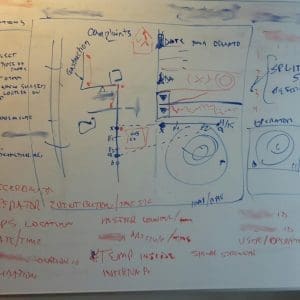Four required competencies for leading innovation - defined, and put in context with examples.
 Often, when trying to figure out how to “make things happen”, your focus switches between multiple targets. What am I doing? Why am I doing this? And How can I get the others to understand what I am doing? Real innovation happens along a continuum that stretches from The Big Idea to Real Results, and people / organizations that want to make real change and true innovation happen need to understand the different elements along the way.
Often, when trying to figure out how to “make things happen”, your focus switches between multiple targets. What am I doing? Why am I doing this? And How can I get the others to understand what I am doing? Real innovation happens along a continuum that stretches from The Big Idea to Real Results, and people / organizations that want to make real change and true innovation happen need to understand the different elements along the way.
Yes, I know – earlier, I suggested that one should pick a specific area (people, process, or technology), and develop your change managements skills there. Still true, but what about those who aspire to transformational leadership, who want to make innovation happen across the organization? A single person doesn’t need to be expert in each of these areas – but leaders should actively work in all of them. Aspire to be a jack of all trades, a master of none; the ability to develop a vision, communicate it with impact, build something actionable, and follow through with the implementation are bankable skills that effective, impactful leaders need.
For each of these “elements”, think of about their definition – but also think of them in context with the other elements of the continuum. A leader with an impractical vision is just a dreamer; breakthrough science that is not well communicated will just sit on the shelf.
Inspiration
Defined: The ability to imagine what is possible (aka Vision). This doesn’t have to be something as earth-shattering as the Internet or as imaginative as the iPad – businesses are crying out for “innovation” in areas as mundane as cost controls, Lean, and revenue growth. Make no small plans, but have the courage and the energy to stretch. Recognize the organization’s practical limits – but don’t sell them short, they might surprise themselves (and you!)
In Context: There is a fine line between imagination and inspiration; we need something that can be implemented in our lifetime. Flights of fancy can broaden your horizons, but you must eventually deliver real business results. This is where you can enable acceptance of the 80/20 rule – a practical vision that sees when enough is enough, that knows when to trim down the requirements to get 80% of the value with only 20% of the effort.
Art
Defined: Innovation often involves ideas, processes, or relationships that are difficult to understand, simply because they involve remixing the As-is with Something New, to create the Could Be. Sometimes it involves visualization – understanding a new structure, a changed process flow, or a hidden trend in the numbers. Sometimes it involves vocalization – an explanation or observation that needs just the right written or spoken words to trigger understanding and acceptance.
In Context: As goods and services are commoditized, and descriptive data becomes freely available in deep detail, the value and importance of design continues to grow. Well designed and executed words, pictures, sounds, thoughts, and ideas are the competitive differentiators that businesses always look for. Great leaders may possess acute verbal and/or visual communication skills, but don’t discount your abilities or overestimate the pizzazz required to make innovation happen in your organization. Just invest time on a regular basis, thinking about the design of things you see and hear every day. What images capture you eyes and your imagination? How do some texts convey meaning without boring you to tears?
Science
Defined: Sooner or later, you will have to create something that doesn’t exist – a new product or service, a simplified process, an effective data visualization, a impactful team. This will always involve some specific “science” – knowledge of an engineering discipline, a programming language, a commercial market, a drawing tool. At one point or another, sustainable innovation must manifest itself as a repeatable, measurable process or event – and sooner or later, you have to be able to translate your hand-waving to something that actually works.
In Context: Inspirational ideas need to find their way to the screen or the printed page, so they can be communicated [effectively], and communicated again [consistently]. The best design ideas need to manifest in the final product. And the best ideas must bridge from the tip of the pencil to something (an app? a web service? a document? a project plan?) that can be executed. The best leaders can still summon hands-on skills when needed; have you built something interesting in the past few months?
Execution
Defined: The classic “rubber hits the road” – results derive from making something happen. This could be the execution of a process, but can also refer to the coordinated steps in a project plan that implements a new product, or establishing rules, structure, and predictability where previously there was random action. Science has created something, now it’s time to get it implemented – and, to make sure the promised results are delivered.
In Context: Starting a new process, stopping an old process, and bringing structure where there is disorder are the typical end results of most business projects, the ways that enterprises create value. However, inertia and entropy are powerful natural forces, and blasting through resistance (this is the way we’ve always done it …) often relies on a strong idea, communicated effectively and designed efficiently.
Master of None
I think the toughest challenge for some entrepreneurs (and intrapreneurs!) is to know when to call for assistance. There is value in knowing everything about a single area (the biggest vision! the best programmer!), but sustainable success often comes to those who know when to call in the experts. The best business results scale across multiple people, teams, locations, business units, processes … so why shouldn’t the best leaders scale across multiple resources?
Never stop learning, never stop improving your skills in all of these areas – but know when to bring in the experts to see results that surpass your expectations.
15 March, 2010
- Leading Change: Pick Something, and Do It Well
- Leading Change: Knowing, Understanding, Empathizing
- Leading Innovation: Inspiration, Art, Science, and Execution
- Empathy Skills for the Transformational Leader
- Fostering Strategic Thinking in a Tactical World: A New Manager’s Guide






Comments (0)